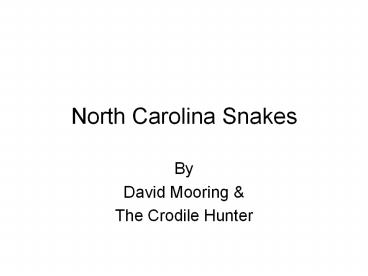North Carolina Snakes - PowerPoint PPT Presentation
Title:
North Carolina Snakes
Description:
North Carolina Snakes By David Mooring & The Crodile Hunter Rat Snake Called Chicken Snake Feeds on rats, mice, birds, reptiles, and chicken eggs Greenish yellow with ... – PowerPoint PPT presentation
Number of Views:461
Avg rating:3.0/5.0
Title: North Carolina Snakes
1
North Carolina Snakes
- By
- David Mooring
- The Crodile Hunter
2
Poisonous Identification
- Pit vipers have pits between each eye and nostril
- Pit vipers have catlike eyes with long and narrow
pupils - Their heads are triangular
- The Coral Snake has a black head
3
Eastern Diamondback Rattlesnake
- North Americas largest venomous snake
- Feeds on rabbits, squirrels, rats, and birds
- Has Rattles
- Has Mask across eyes
- Can be 8 feet long, but usually 5 feet
- Found in Pine flatwoods and brushy fields
4
(No Transcript)
5
(No Transcript)
6
Pygmy Rattlesnake
- Small and fat snake
- Found near flatwoods, wiregrass, and along
marshes - Feed on frogs, lizards, Mice, and small snakes
- Small rattles sound more like a Buzz
7
(No Transcript)
8
Canebrake Rattlesnake
- Also called Timber Rattler
- Feeds on Rodents and other small animals
- Feed in day and night (Mostly night in hot summer
months) - Found all over NC and water
- Hides under stumps and woody cover
9
(No Transcript)
10
(No Transcript)
11
(No Transcript)
12
(No Transcript)
13
Copperhead
- Also called White Oak or Red Oak Snake
- Very Aggressive
- Feeds on Cicadas, Caterpillars, frogs, mice,
lizards, and birds - Lives in woody areas near rocks, ponds, streams
- Active at night during hot summer
- Warm surfaces in cool months
- Hourglass shape across back
14
(No Transcript)
15
(No Transcript)
16
(No Transcript)
17
Water Moccassin
- Also Called Cottonmouth
- Found on or near water
- Feeds at night on fish, amphibians, birds and
reptiles - Stripe on side of head
- Bite more toxic than Copperhead
18
(No Transcript)
19
(No Transcript)
20
Coral Snake
- Spends most of his life under sandy soils
- Found in sandhills woods and wiregrass
- Feeds on small reptiles and own species
- Not Pit Vipers, related to Cobras Sea Snakes
- Not aggressive, must chew to bite
- Black Head
- Red and yellow kills the fellow
21
(No Transcript)
22
(No Transcript)
23
Hognose Snake
- Also called Puff Adder, bluffs with puffed head
and neck - Thrashes tail, hisses, and rolls over and plays
dead - Feeds on toads, insects, frogs, and mice
- Has upturned point on snout
- Individuals have varying colors
24
(No Transcript)
25
(No Transcript)
26
Red Belly Water Snake
- Color varies from reddish brown to pinkish gray
- Prefers wet, but will travel on rainy days
- Feeds on frogs, toads, and fish
- They will bite and discharge a fowl smelling musk
- Their belly is reddish orange
27
(No Transcript)
28
Eastern Milk Snake
- Feeds on Mice, Snakes, and Lizards
29
(No Transcript)
30
Northern Black Racer
- White patch under skin and throat
- Lives in brushy areas and under boards and tin
around old buildings - Feed on insects, eggs, mice, frogs, and lizards
- Will coil and rattle (bluff) tail when cornered
or hurt
31
(No Transcript)
32
Corn Snake
- Black and White Checkered Bellies
- Easily kept in captivity, good pets
- Feeds small rats, frogs, and lizards
- Red, gray, orange or black patches
- Generally an orange colored snake
33
(No Transcript)
34
(No Transcript)
35
(No Transcript)
36
Rat Snake
- Called Chicken Snake
- Feeds on rats, mice, birds, reptiles, and chicken
eggs - Greenish yellow with four brown or black stripes
down its side (black with spotted gray and white
belly
37
(No Transcript)
38
Juvenile Black Rat
39
Gray Rat
40
Black Rat
41
Coachwhip
- When picked up it will bite repeatedly. It will
run when it sees people. - Feeds on mice, eggs, birds, snakes, lizards
- Moves quickly on grassy dunes, wiregrass, pine
sandhills, and maritime forests
42
(No Transcript)
43
Eastern Garter
- Variety of colors and patterns (blue, brown,
green or red with black or brown spots and/or
stripes - They like moist areas
- Feeds on frogs, worms, salamanders, small fish
and toads - Exacting moisture environmental requirements
44
(No Transcript)
45
Stripped Garter
46
Southern Green Snake
- 14-26 inches long, thin like a pencil
- Green in color
- Likes grassy areas, trees, and shrubs
- Eat insects and spiders
47
Smooth Green Snake
48
Rough Green Snake
49
Scarlet Snake
- Red blotches surrounded by black on back (similar
to Scarlet King Snake, Corn, and Coral) - Does not have a black head like Coral Snake
- Blotches surrounded by belly color
- Feeds on insects, lizards, small snakes, reptile
eggs, and mice
50
(No Transcript)
51
Eastern King Snake
- Un-aggressive and secretive daytime snake
- Found around sawdust plies, old buildings, grass,
and under shrubs - Feeds on snakes including copperheads, eggs,
mice, and lizards - Venom immunity
52
(No Transcript)
53
Ringneck Snake
- Black or slate gray snake with ring around neck
same color as belly (yellow to orange belly) - Found under flat rocks, logs, or loose bark of
dead trees - Feeds on worms, slugs, salamanders, lizards, and
newborn snakes. - They coil into a ball
54
(No Transcript)































